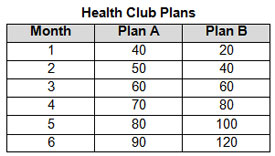Question 1
Marco is shopping for a new game system and games. System A costs $295 plus $19.95 per game. System B costs $195 plus $24.95 per game. Which system of equations could be used to determine how many games he would have to buy for the two systems to cost the same? Let s represent the total cost of the game system and games and g, the number of games purchased.
Question 2
A student works at Better Buy and earns $30 for each computer sold. The store's manager earns a base salary of $2100 per month plus $20 for each computer sold. Write a system of equations to determine the number of computers that the student would need to sell in a month to make the same salary as the manager. Let s represent the salary and c represent the number of computers sold.
Question 3
Angela is starting college in the fall. She goes to the campus bookstore to buy books for her classes. New books, n, cost $65 each and used book, u, cost $30 each. Angela purchased a total of 8 books and spent a total of $310. Which system of equations could be used to determine the number of new and used books she purchased?
Question 4
As a fundraiser, the student council plans to sell tickets to a dance. The tickets will cost $9 if purchased early and $12 if purchased at the door. Due to limited space, the student council can sell no more than 300 tickets and hope to raise more than $2700. Let e represent the number of tickets purchased early and d represent the number of tickets purchased at the door. Write a system of inequalities in standard form to represent this situation.
Question 5
An athlete is training during the summer. He walks at a rate of 6 miles per hour and bicycles at a rate of 18 miles per hour. His coach recommends that he train for no more than 4 hours per day and cover a minimum of 50 miles. Let w represent the number of hours the athlete walks and b represent the number of hours the athlete bicycles in a day. Write a system of inequalities than can be used by the athlete to determine the possible combinations of hours spent walking and bicycling.
Question 6
Selected values from a system of equations are shown in the table below.

Which line of the table shows the solution to the system?
Question 7
A local health club offers two different membership plans. Plan A costs $30 plus $10 per month. Plan B costs $20 per month. The table below shows the total cost of each plan for 6 months.

Which of the following is NOT a true statement about the two membership plans?